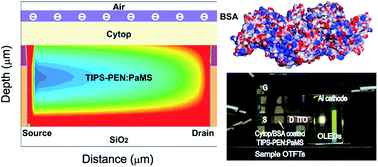Improved output characteristics of organic thin film transistors by using an insulator/protein overlayer and their applications
Abstract
We herein present our study of the effect of an insulator/protein overlayer deposited onto semiconducting active layers in organic thin film transistors (OTFTs) with regard to their electrical performance. The active layers used were composed of 6,13-bis(triisopropylsilylethynyl)-pentacene (TIPS-PEN) blended with poly(α-methylstyrene) (PaMS), and the overlayer consisted of a bottom insulating (protecting) layer of an amorphous perfluoropolymer (Cytop) and a top protein layer of negatively charged bovine serum albumin (BSA). The functional layers were deposited using a simple solution-coating method which involved a horizontal dip coating process. We show that the Cytop/BSA overlayer on the TIPS-PEN:PaMS active layer improved the electrical performance of the OTFTs; the devices with the Cytop/BSA overlayer exhibited an average effective mobility of 0.25 cm2 V−1 s−1, which was higher than that of bare devices without any overlayer (0.20 cm2 V−1 s−1). This improved performance of OTFTs with the overlayer was successfully simulated and was found to stem from the formation of a second current channel in the TIPS-PEN:PaMS active layer via the electric field effect of the negatively charged BSA overlayer. These results demonstrate that OTFTs employing charged protein overlayers show considerable promise for the production of high-performance OTFT devices.


 Please wait while we load your content...
Please wait while we load your content...